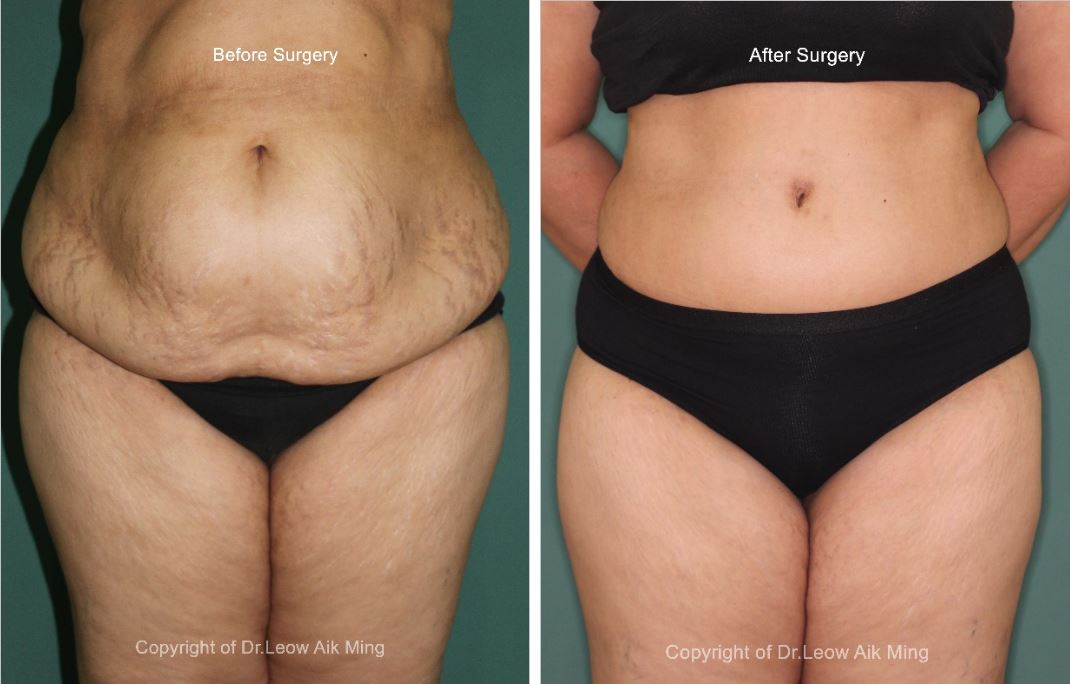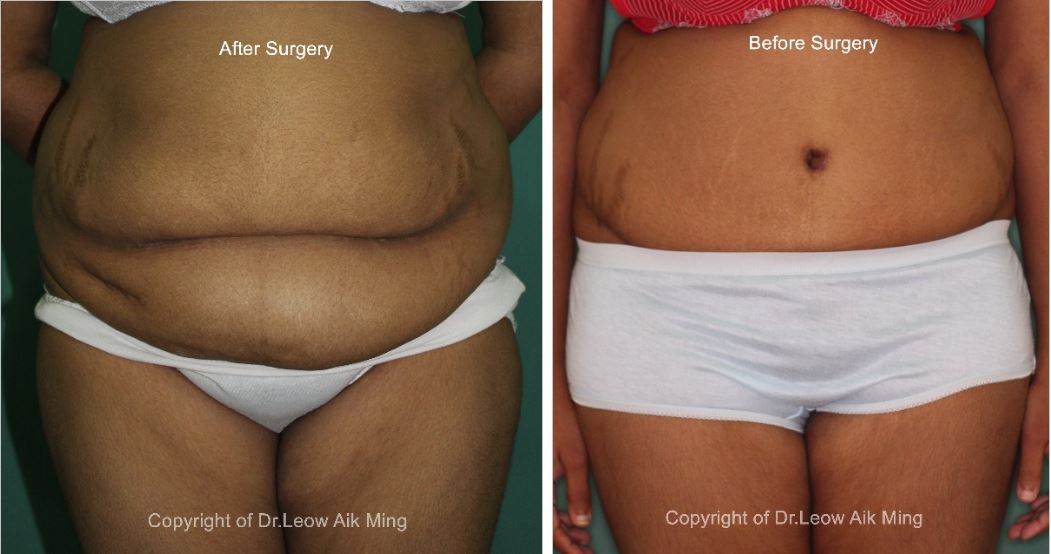Healthy individuals of otherwise normal body weight and proportion can develop a protruding abdomen wall with loose or sagging skin. The most common causes of this include:
- After pregnancy
- Ageing
- Significant weight loss
- Heredity
- After bariatric (weight reduction) surgery
Abdominoplasty (tummy tuck surgery) is a cosmetic surgical procedure that removes excess skin and fat from the middle and lower abdomen. Abdominoplasty also helps to restore weakened or separated muscles and tighten the muscle and fascia of the abdominal wall, thus creating an abdominal profile that is smoother and firmer.
In general, the surgical approach to a full abdominoplasty follows these steps:
- The incision made below the panty/underwear line (from hip to hip above the pubic area)
- Another incision made to release the belly button
- Excess skin and fat tissues removed (below the belly button)
- Release of the anterior abdominal wall flap
- Repair of the weakened muscles and fascia
- Reconstruction of the belly button
- Anterior abdominal wall flap is draped and positioned to the incisional wound made
- Closure of the wounds
The approach to abdominoplasty may vary depending upon the patients’ indications. Some of these variations include:
- A mini or partial abdominoplasty (smaller incision made compared to full abdominoplasty)
- Extended abdominoplasty (longer incision than full abdominoplasty with a lateral thigh lift)
- Circumferential or belt abdominoplasty (extended abdominoplasty with a buttock lift)
Abdominoplasty is not an alternative approach for weight loss or exercise program. Abdominoplasty cannot correct stretch marks completely, although some of these may be removed if they are located in the areas of excess skin below the belly button. The results of an abdominoplasty procedure are permanent, and significant fluctuations in body weight can significantly diminish the positive outcome. For this reason, individuals who are planning for substantial weight loss or women who may be considering future pregnancies may be advised to postpone the abdominoplasty. Occasionally, previous abdominal surgery may limit the possible results of a tummy tuck. In women who have undergone a caesarean section, the existing scars may often be incorporated into the new scar.
Therefore, abdominoplasty is a highly individualised surgical procedure for a specific individual. This surgery is ideal for candidates who are motivated and have realistic expectations on their body shape.
Ideal candidates for abdominoplasty
- Healthy individuals who do not have a life-threatening illness or medical conditions that can impair healing
- Individuals who are motivated and have specific goals in mind to improve the body image
- Individuals with stable weight
- Non-smokers
Preoperative evaluation for abdominoplasty
Communication is vital to achieving the patient’s goals. During the initial consultation, patients will have the opportunity to discuss their goals and desired results with the plastic surgeon. The plastic surgeon will work closely with the patients to reach an agreement about the expectations from the surgical procedures involved and their long term benefits. Every patient is different. Therefore a specific treatment regimen is planned to suits an individual’s need. The preoperative evaluation for abdominoplasty includes:
- Discussion about patients’ expectations and desired outcome
- Medical conditions, drug allergies and previous medical or surgical treatment
- Use of current medications, vitamins, herbal supplements, alcohol, tobacco and drugs
- Discussion of type of anaesthesia
- Examination of the anterior abdominal wall
- Photography for preoperative and postoperative evaluation
Preparation for abdominoplasty
- Get laboratory testing or a medical evaluation
- Adjust your medications if you have certain medical conditions
- Stop smoking and alcohol well in advance before the scheduled date for surgery
- Avoid taking aspirin, anti-inflammatory drugs and herbal supplements before surgery
- Special instructions will be given on the day before and after surgery
The risks and safety information on abdominoplasty
It is crucial for patients to understand that every surgical procedure has its complications and downtime. However, if a patient is appropriately assessed before the surgery and postoperative care is given adequately, these risks can be eliminated or reduced.
Some of the common risks of abdominoplasty:
- Infection
- Bleeding
- Poor wound healing
- Wound breakdown
- Skin discolouration
- Swelling due to a blood clot or fluid accumulation
- Fluid accumulation
- Scarring
- Temporary numbness or changes in the skin sensation
- Asymmetry
- Recurrent loosening of skin at the lower abdomen
- Possibility of revision surgery
- Anaesthesia risks such as deep vein thrombosis, cardiac and lung complications
Postoperative expectations
After the surgery, temporary dressings or bandages are applied to the incision sites. Small tubes are temporarily placed under the skin to remove any excess blood or fluid that may be collected after the surgery. Once the tubes and temporary dressings are removed, the patient is advised to wear a compression garment (for 4-6 weeks) to minimise the swelling and support the abdomen during the healing phase. There may be swelling, bruises, discomfort or pain at the operated sites for several days that can be controlled with oral medications. Oral antibiotics and analgesics will be prescribed to reduce the risk of infection and postoperative pain, respectively. Stitches will be removed on 7-10 days after the surgery. The final result of surgery will appear within several weeks, but it may take up to a year for incision lines to fully refine.
Case No. 1:

Case No. 2:
Case No.3:
Postoperative care
- Regular application of antibiotic ointment and cleaning the operated areas for the first one week after the surgery
- Wear compression garments for 4-6 weeks
- Brisk walks can be started two weeks after the surgery
- Routine exercise may be resumed in 4 weeks after the surgery.
- Avoid strenuous physical activities for the first six weeks
How much will an abdominoplasty surgery cost?
Cost is always a consideration in elective surgery. The cost of abdominoplasty can vary widely.
The cost of abdominoplasty may include:
- Surgeon’s fee
- Hospital or surgical facility costs
- Anaesthesia fees
- Compression garment
- Prescriptions for medication, and
- Medical tests
Abdominoplasty is a cosmetic surgical procedure, and most of the health insurance does not cover cosmetic surgery or its complications.
